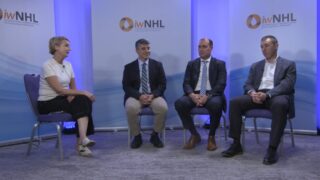This study is a Phase I investigator-initiated trial studying the safety of the combination of loncastuximab tesirine with venetoclax based on preclinical findings that the combination of loncastuximab with the BCL2 inhibitor could increase its activity. The study includes multiple subtypes of diffuse large B-cell lymphoma and patients who have had two or more prior therapies and the agents are combined with venetoclax at a flat dose of 400 milligrams per day with initial ramp up on the first week of treatment and then continuing only for five days of each cycle...
This study is a Phase I investigator-initiated trial studying the safety of the combination of loncastuximab tesirine with venetoclax based on preclinical findings that the combination of loncastuximab with the BCL2 inhibitor could increase its activity. The study includes multiple subtypes of diffuse large B-cell lymphoma and patients who have had two or more prior therapies and the agents are combined with venetoclax at a flat dose of 400 milligrams per day with initial ramp up on the first week of treatment and then continuing only for five days of each cycle. The dose escalation plan is using a schema with venetoclax at a flat dose of 400 milligrams from day one through five of each cycle with ramp up on the first cycle and loncastuximab is dose escalated at three dose levels with the first dose level of 50 micrograms per kilogram, the second dose level at 100 micrograms per kilogram, and the third dose level 150 micrograms per kilogram. We have been able to dose escalate to the maximum dose 150 micrograms per kilogram. The regimen has been relatively well tolerated. We enrolled 16 patients so far with the most frequent side effects, including hematologic toxicities, with most of them having been grade 2 or 3. And we’ve had a few patients having increased creatinine, but most of them have been grade 1. In addition, we have found that 47% of patients have had a complete disease response. And we have seen that most of the patients were heavily pretreated with a median number of prior lines of therapy of four lines of therapy, including nine patients having had, none of the 16 patients having had prior CAR T-cell therapy, as well as a comparable number of patients receiving prior bispecifics, suggesting that the combination of loncastuximab with venetoclax is relatively well tolerated. It has clinical activity with a complete response rate of 47%, and it can be used to treat patients who have been previously heavily retreated, including patients with diffuse large B-cell lymphoma, as well as patients with high-grade lymphoma who have received prior CAR T-cell therapy.
This transcript is AI-generated. While we strive for accuracy, please verify this copy with the video.















